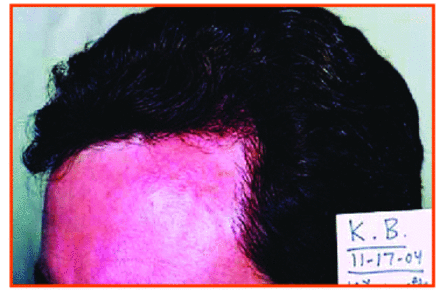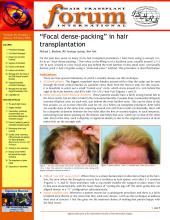For the past four years, in many of my hair transplant procedures, I have been using a concept I refer to as “focal dense-packing.” This refers to the filling in of a localized zone, usually around 2.5–3 cm2 in area, located in a key visual area just behind the front hairline. In this small zone, I personally densely pack 2-hair FU grafts using a “stick-and-place” method. This procedure is described below.
Indications
There are four special indications in which I virtually always use this technique:
All female patients. The biggest complaint most females present with is that the scalp can be seen through the front-central hairline as someone views them from the front or side. For this reason, it is beneficial to select out a small “frontal core” circle, which starts around 0.5–1cm behind the edge of the front hairline, and fill it with 110–150 2-hair FUs (Figures 1 and 2).
Males with deep fronto-temporal recessions. These patients usually have a fairly strong frontal tuft in the front-center, but are thin or bald in the recessions laterally. I usually draw a somewhat obliquely oriented elliptical zone on each side, just behind the front hairline zone. This can be done at the first session, or, as is more often the case for me, at a follow-up transplant procedure. Both sides are usually done at the same time, requiring around 260–300 FUs in total. Occasionally, there will be a disparity of density between the two sides after the first or second surgery. In such instances, performing focal dense-packing on the thinner side helps that area “catch up” to that of the other side. Most of the time, such a disparity in apparent density is due to the original presence of more native hair on the stronger side.
Difficult “cow-lick” areas in front. Where there is a sharp demarcation in direction of hair at the hairline, the area where the divergence occurs has a tendency to look sparse, even after 2–3 sessions (Figures 3, 4, and 5). Stick-and-place with a 21g needle enables the surgeon to place many FUs in this area atraumatically, with the least chance of “cutting the legs off” the other grafts that are aligned almost in a “V” configuration subcutaneously.
Patient complaint area. Whenever a patient returns for a subsequent procedure and there is a fairly localized area that he or she notes that they wish were denser, I will use this technique to address their area of concern. I feel this gives me the maximal chance of making that patient happy with the final result.
49-year-old female with small “frontal core” area drawn in. 110× 2-hair FUs placed in 19g sites in frontal core zone, along with regular transplant session around it.
Same patient, 1 year 11 months later, after one session.
42-year-old male with “cow-lick” of divergent hair direction in front-center.
Small oval area filled in with 95× 2-hair FUs in 20g and 21g sites, along with FU transplanting of surrounding area at lesser planting density.
Same patient, 1 year later, with cow-lick area filled in and less noticeable.
My Method for Focal Dense-Packing
When I first started using this method, it was exclusively in females and I figured that using the maximal number of hairs per recipient site would give the greatest return in density. Therefore, I selected the 3-hair FU as my “work horse.” I used all 3-hair FUs in the first 20–30 such patients, usually placing them in 18g needle sites (occasionally 19g for fine hair). I then held off doing any more cases until I could evaluate some of these patients 9–10 months later. To my surprise, I found that in over half the growth was very subpar and disappointing. Figuring that perhaps the needle sites were too large and traumatic to the grafts’ blood supply, I then switched to using all 2-hair FUs and placing them in smaller sites, using mostly 20g and 21g sites and only 19g when the patient’s hair was coarse. I now use 21g needle sites for the great majority of cases. The assistants are instructed to pick out the best 120–150 2-hair FUs they can find. We refer to them as “tight two’s,” meaning that the hairs are closely aligned together and parallel without “teepeeing,” and there are no miniaturized hairs present. Normally, we also seek to only use well melaninized hairs. If the patient has a natural blend of “salt and pepper” hair color distribution, then one does have to include some white hairs, to avoid this small circular area from sticking out as an abnormal swath of dark color.
I mark off the intended focal area with a purple surgical pen, to help remind me not to place any of my pre-made incisions within those boundaries. When the pre-made sites are completed, I then obtain the selected 2-hair FU grafts from the assistants and do the stick-and-place procedure myself with 3× magnification. Within the circular (or oval or elliptical) outline, I place each graft into the site just as the needle edge is prying open the site as it is removed. The needle is then used to stabilize the graft’s placement so it doesn’t slide out. I try to place the next graft in a different area of the small zone, rather than immediately adjacent to the most recently placed one, to help prevent “popping.” A quick thrust of the needle helps to minimize popping of the nearby grafts. Before beginning the placement of these grafts, I inject a small amount of tumescent saline with 1:150,000 epinephrine with a 27g needle into the area. If one overdoes this, the fluid competes for the space that you want to place the grafts into. I keep jumping around from one part of this zone to another, gradually “filling in all the cracks” until I can’t place any more. The density of planting is usually in the 40–60 FU per cm2 range, depending on the caliber of the hair, because I can get much greater density using the 21g needles in patients with finer hair (Figure 6). Obviously, the diameter of the hair shaft is the biggest contributor to final maximal visual hair density, so the results are actually better with coarse hair at 40/cm2 than fine hair at 60/cm2.
125× 2-hair FUs just placed in 21g and 20g sites within a 2.5cm2 area in female patient.
General Comments
In contrast to my experience with the 3-hair grafts in mostly 18g sites, I have noticed almost uniformly excellent growth with the 2-hair FU grafts planted into smaller sites. The number of hairs I can fit into a small area is actually greater, simply because smaller needle sites can be used. I haven’t used custom-made lateral slits for focal dense-packing yet, simply because I like the slight dilating affect that a needle provides to a recipient site. I find these sites help me to more atraumatically get the graft inserted. I feel strongly that the key to high survival of grafts placed very close together is the size of the recipient site. The smallness of the site, especially on the first “virgin” session, gives the surgeon tremendous leeway and freedom to pack densely, especially if the scalp is reasonably thick. Based on previous research studies of mine, I think this becomes less true on subsequent surgeries in the same area and in patients with noticeably thin scalps.
The obvious question someone might ask would be: Why not use this method to do the whole transplant? In 95% of my patients, I am addressing a fairly large area, usually the entire frontal and mid-scalp areas, along with the side temple areas in nearly half of these. I feel this is too large an area to use this technique on, in my opinion, for three reasons. First, I have serious doubts about the vascularity of the scalp supporting this type of dense-packing over a large area, even if the necessary grafts were available, and second, I don’t want to take that much donor hair out at one time, risking a wide donor scar or telogen in the donor area from a tight closure. A third reason is that I prefer to make all of my own sites and not to delegate this task. I have come to the opinion that for smaller areas needing transplanting, such as patients who only need the frontal rim and temples filled in, “dense-packing” with lateral slits is the optimal way to proceed, usually requiring around 2,000 FUs in my hands (Figures 7 and 8). For everyone else, where a large area of the thinning scalp is being addressed, I believe it is wisest to back off a little in the density of graft placement and complete the project in 2–3 sessions. But, for this large group of people, I find it helpful to have this “focal dense-packing” tool in my armamentarium to create “instant density” in those small areas and instances when it is needed.
39-year-old male desiring fill-in of frontal rim and temple areas. Dense-packing with lateral slits was used throughout the area, using 2,000 FU grafts.
Same patient, 11 months later, after one session.
- Copyright © 2008 by The International Society of Hair Restoration Surgery














